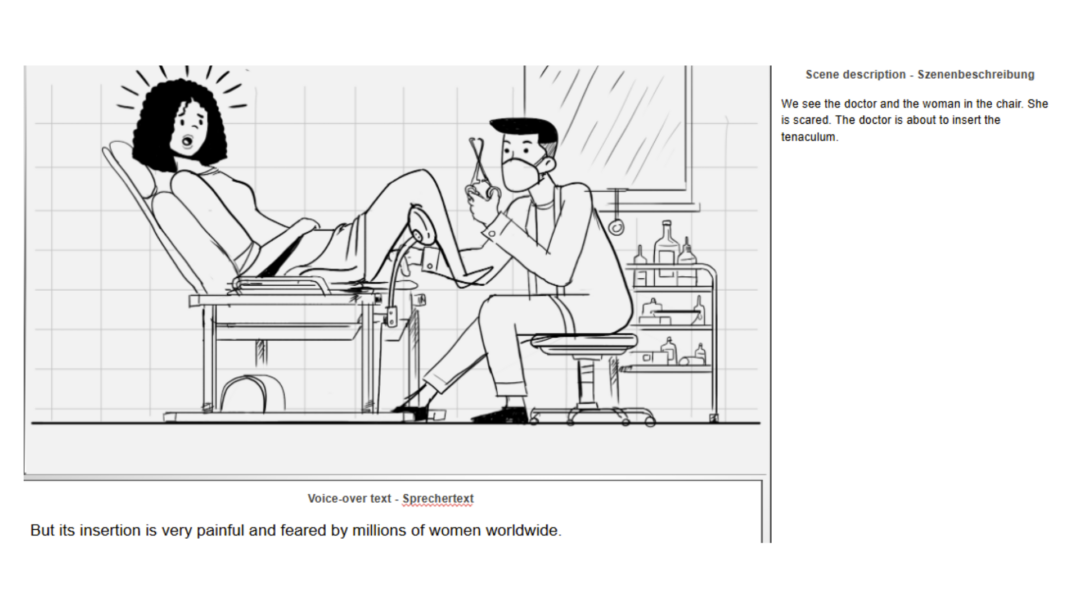What Is a Storyboard in Science Animation?
👉 Curious about all the steps involved in creating a science animation? Here’s our full guide.
A storyboard is “a graphic organizer that consists of illustrations or images displayed in sequence for the purpose of pre-visualizing a video, animation, or motion graphic” (Wikipedia).
In short, it’s the first visual version of your story, before any animation starts.
A storyboard in science animation is the invisible backbone of every powerful scientific video. It’s where complex ideas begin to take visual shape—long before motion, color, or narration come into play.
But what exactly is it? And why is it essential for turning life science into a story that sticks?
Let’s break it down.
Inside a Storyboard in Science Animation: Real Example
Take a look at this example from a storyboard in science animation we created for a medtech company:
At first glance, you see a sketched woman in a medical chair, visibly tense. A masked doctor prepares an instrument—the tenaculum. It’s not animated yet. It’s not voiced. But everything is already there: emotion, clarity, and impact.
Now let’s break down what this storyboard frame includes:
- Voice-over text: “But its insertion is very painful and feared by millions of women worldwide.”
→ This comes directly from the script and drives the emotional message. - Scene description: “We see the doctor and the woman in the chair. She is scared. The doctor is about to insert the tenaculum.”
→ This guides the illustrator and later the animator on what exactly must be shown. - Sketch: A simple but clear visual that shows framing, perspective, and mood.
Why a Storyboard in Science Animation Matters
A storyboard in science animation does much more than organize ideas. It:
1. Aligns Everyone Before Production
Scientists, creatives, and stakeholders often speak different languages. The storyboard creates a common visual and narrative reference point for all.
2. Simplifies Feedback and Revision
It’s far easier (and cheaper) to revise sketches and descriptions than full animations. This saves time, budget, and frustration.
And we go as far as needed—our clients can request as many revision rounds as necessary. They get a clear idea of what will be shown and can shape the story exactly as they envision it.
3. Turns Complex Science into a Clear Visual Flow
Whether it’s a molecular pathway or a medical device in use, a storyboard in science animation helps define what the viewer sees, in what order, and how it all connects.
Why Storyboarding Is the Hardest—and Most Crucial—Step
Translating plain script text into a storyboard in science animation is the most challenging part of the production.
Why? Because it requires a rare mix of:
- Scientific understanding – to grasp what’s truly important,
- Creativity and illustration skills – to visualize it clearly,
- Animation expertise – to ensure everything flows logically and emotionally.
This step is where we transform knowledge into narrative. It’s not just drawing—it’s story architecture.
What Comes After the Storyboard in Science Animation?
Once the storyboard is fully approved, we move on to the designboard.
Here’s how it works:
- Every scene is fully illustrated in the final style.
- Colors, lighting, tone, and detail are added.
- It looks exactly like the finished video—just not moving yet.
Only after this designboard is approved do we begin the animation. This way, there are no surprises—just a smooth path forward.
The Power of a Well-Built Storyboard in Science Animation
Without a storyboard, science animations can easily become vague or confusing. With a strong storyboard, every second of your video is purposeful, clear, and memorable.
So next time you watch a science video that just works—chances are, it started with a well-crafted storyboard in science animation.
Want to see how your science story would look in storyboard form?
Let’s chat. We’ll turn your breakthrough into a clear, compelling visual story—frame by frame.

